January 13, 2019
It’s close to 11:30 PM on Saturday, January 12th as I’m starting to write this post. I finished my first Calabria Dispatch a few hours ago. At the time, I planned to start Dispatch #2 after dinner with the goal of finishing and posting it on the 13th.
That’s still the plan but this evening has put a sharp turn in my planned story line about massive food consumption. Stick with me and you’ll see why.
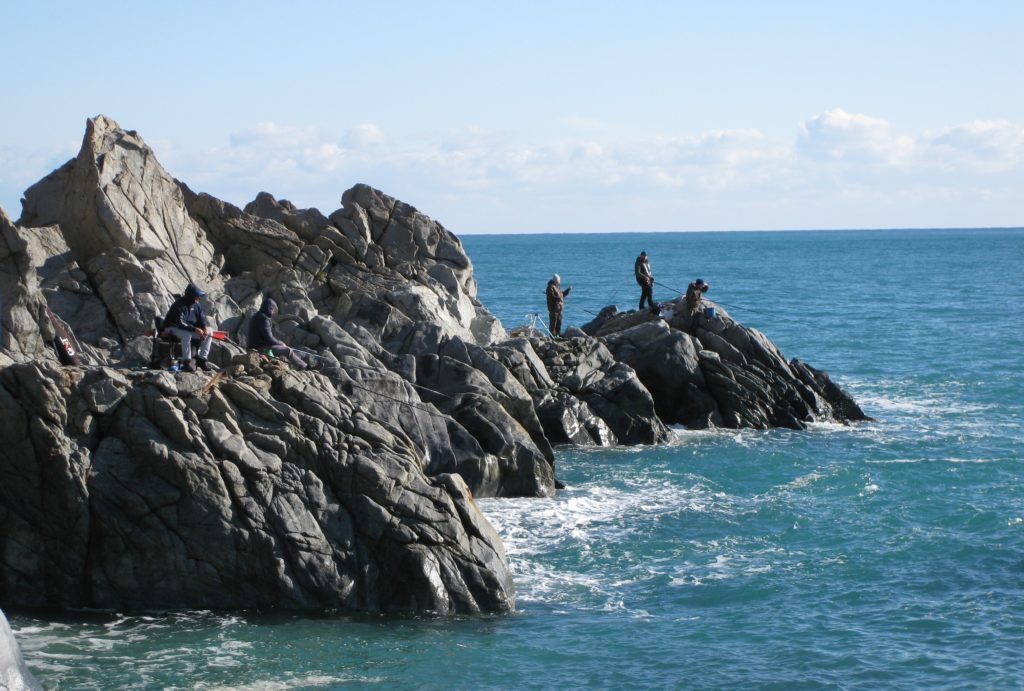
Last time I stopped my tale at 2:00 PM on Thursday, January 10th. We had just gotten back from lunch and started in the kitchen.
From 2:00 to 5:00 one cured meat product after another was inaugurated in the kitchen. These included three types of pancetta, proscuittino, cotechino (which I prepared and wrote about in my first blog of the new year), zampone, duck prosciutto, rabbit and duck liver paté, cured rabbit leg, bratwurst and kielbasa (yes, I know this is a course on Italian cuisine), and on and on.
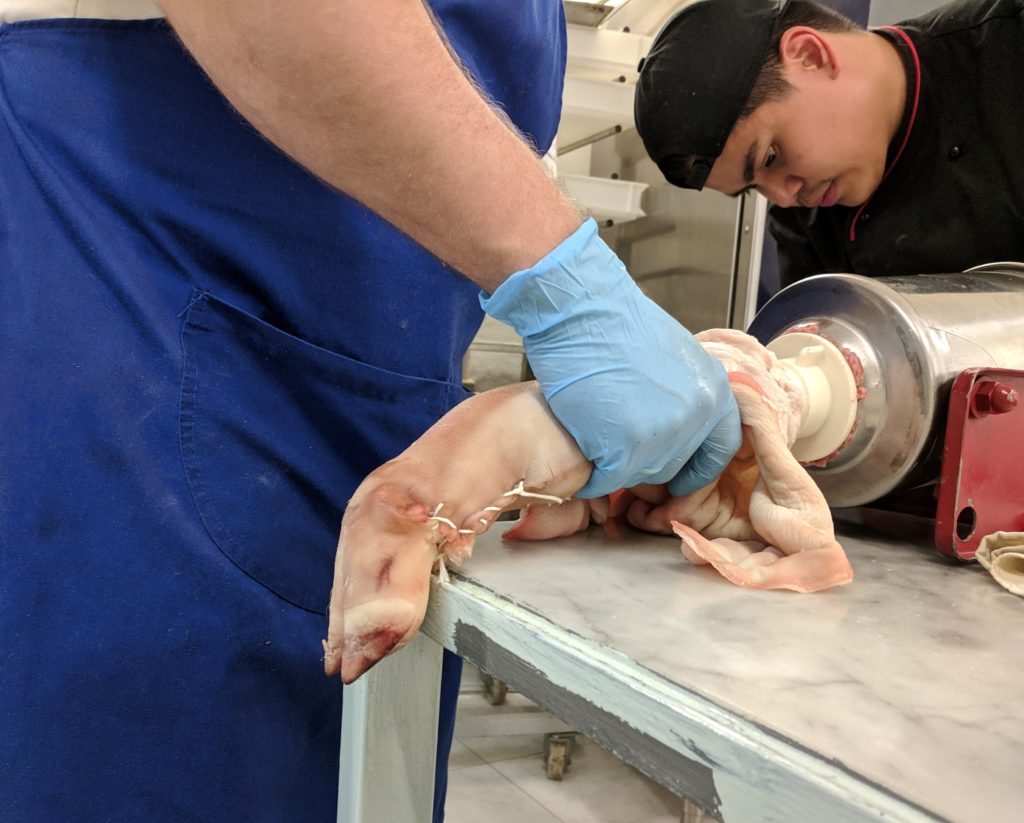
Each of the ground meat products was subjected to testing, meaning a portion was cooked, divided up and passed around the room for all to taste. We discussed what adjustments needed to be made to the seasonings. Often a second round of testing ensued before the mixture was declared perfect and put in casings.
Cotechino was among the most challenging to test because it contains about 30% pork skin. Pork skin requires hours of cooking, even when ground finely, to be palatable. The texture of the quickly-cooked cotechino resembled ground up hockey pucks. We knew this would be the case. The point was to taste for the perfect balance of seasonings, not the texture of the finished product.
Half the cotechino mixture was made into a fat sausage (cotechino) and half was stuffed into a pig’s trotter to make zampone. Zampone means trotter. Zampa means paw. Zampa also happens to be my mother-in-law’s maiden name.
At 5:00 we took a break and were served platter upon platter of cured meat products, such as head cheese, that had been made in the previous few days along with enough wine to wash it all down. For good measure, bowls of pasta carbonara were brought out. Round about this time, those folks who had succumbed to Mariana’s encouragement to have two panini at the Panino Lab at lunchtime were regretting their decisions.
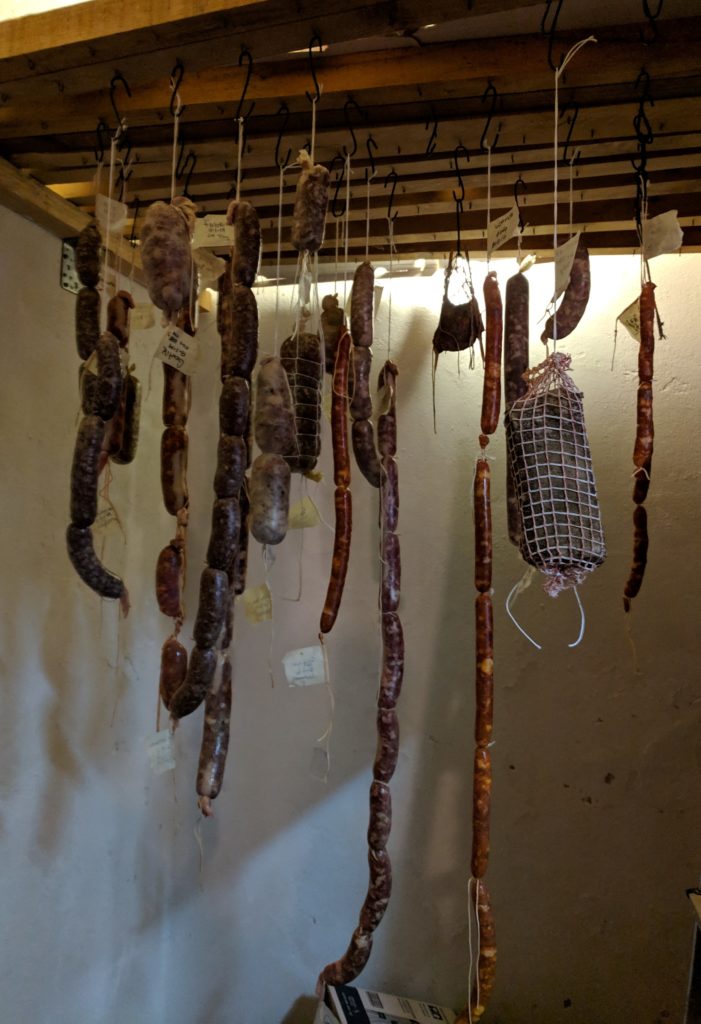
We resumed around 5:30, marching down to the curing room where meats were hung to cure. It was absolutely fascinating to me to see Chef Juan light olive branches to lightly smoke all the meat products. He said that in Calabria it is traditional to smoke all aged cured meat products for an hour twice a day for four days. Never in my life had I heard this. It certainly does not appear in any of the tomes on salumi that I have read! This is a topic that I need to explore further in the coming weeks.
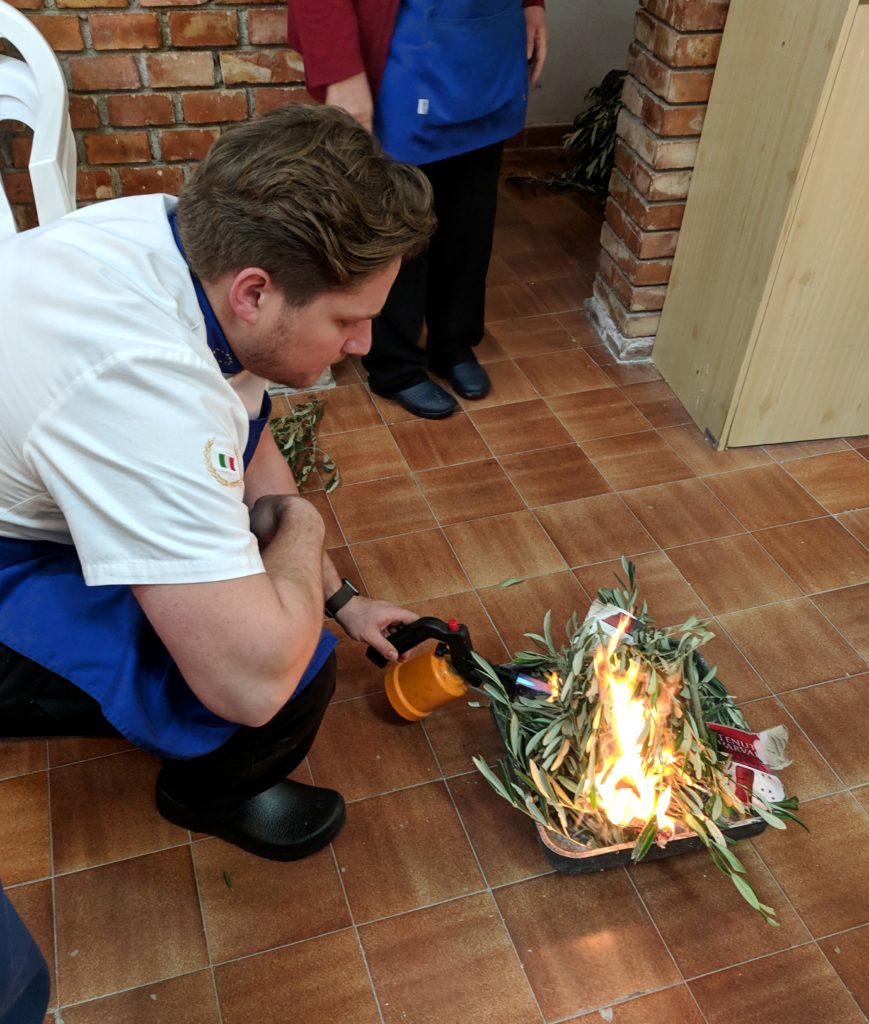
In addition, though not strange to me, is that the Institute only uses salt to cure its meat products. In the States we would call these “uncured” because we use the term “cured” to mean that preservatives such as sodium nitrate and sodium nitrite have been added as well, ignoring the fact that salt is, itself, a “cure.” Curing with salt alone is generally believed to be too risky for the home cook. Sodium nitrate and sodium nitrite are much more effective antibacterial agents than salt alone. They also help meat to maintain a more attractive reddish color.
We went back to the kitchen and continued with meat production until shortly after 9:00 PM, at which time we were told to prepare for dinner! Mind you, we had already had a stupid amount of food for the day. Dinner consisted of pounds and pounds of fresh sausages that had been prepared over the previous days, salad and bread all lubricated with the ever-present wine. We ended with gelato and cake.
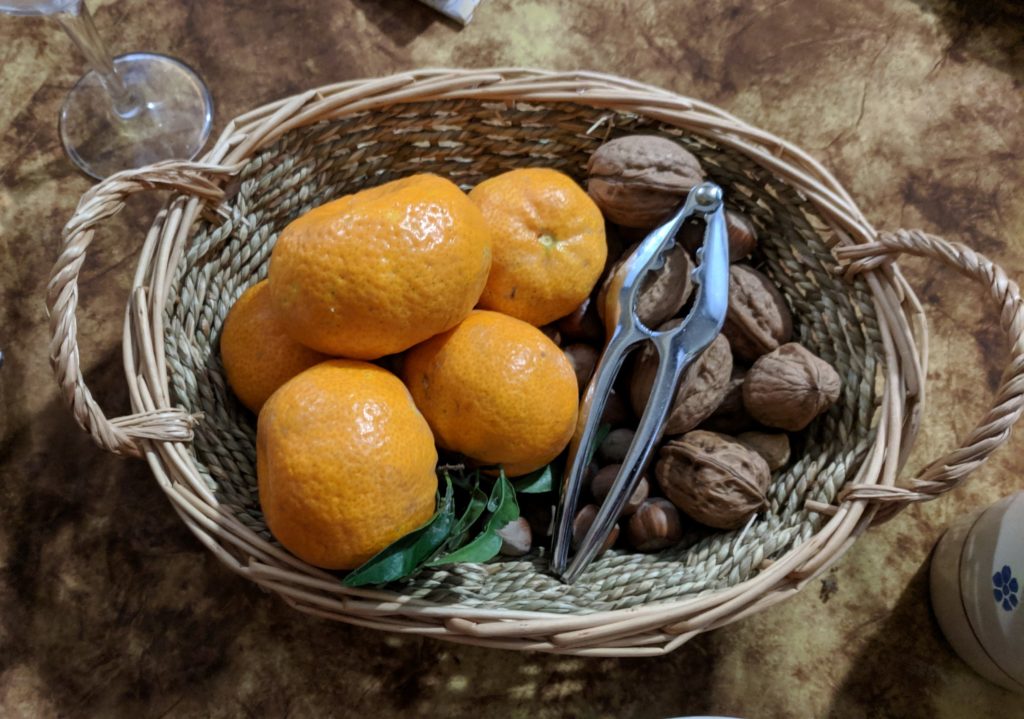
The previous night, Chef Juan had announced at the end of dinner that if we had brought any “gastric protectant” with us (i.e. some sort of antacid or acid blocker) we should start taking it that night in preparation for “massive eating” the next day. He did not exaggerate.
I’ve read many articles about chefs who travel to experience local cuisine to develop new ideas for their restaurants. The stories always involve eating the same stupid amount of food, if not more. There’s really no way to taste food without swallowing it and one bite is often not enough to fully appreciate the taste and texture. In the cooking profession, eating is research, and the more research one does, the better. Periodic over-indulging goes with the territory.
Friday the 11th was a relatively mellow day. The few remaining outgoing students and the few incoming students who had arrived were invited to lunch at La Tavernetta, the restaurant at Baia dell’Est, the hotel at which we’re staying. Lunch started with two gorgeous crustaceans, langoustine tails, I think, but also possibly a species that doesn’t get exported. They were wrapped with cooked angel hair pasta and flash fried to crisp the pasta and cook the seafood. It was a brilliant preparation. There was also a portion of monkfish wrapped in seaweed and cooked. Next was seafood ravioli in a light tomato sauce. The meal ended with deconstructed cannoli and Amaro del Capo, one of scores (probably really hundreds) of amari made throughout Italy.
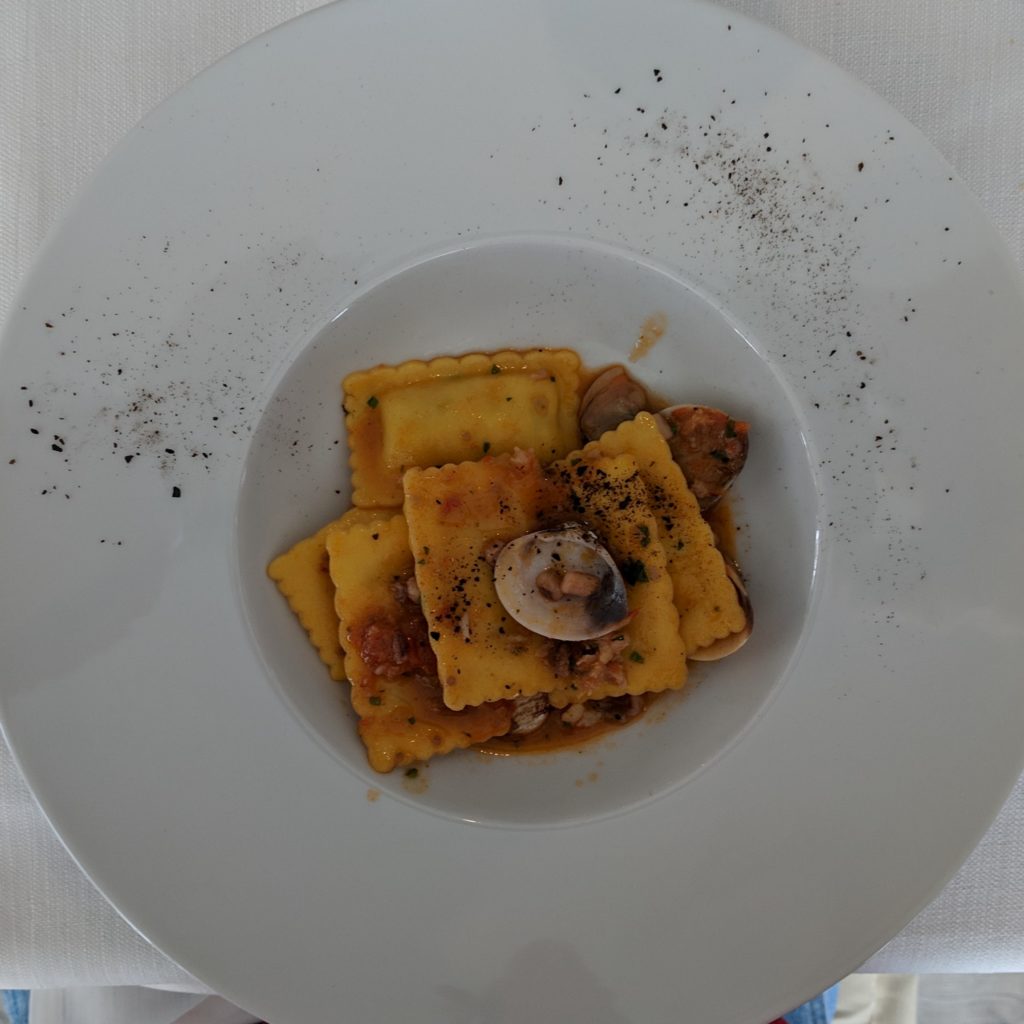
For dinner, the ever-growing group of incoming students went to the pizzeria from my first night (the one with the automatic defibrillator). I had Pizza Diavola. Sliced fresh hot peppers were strewn on the pizza before baking. I confirmed that the fat in cheese is a perfect vehicle for capsaicin. Every bite of pizza was searing in spiciness, even if that particular bite didn’t contain an actual slice of hot pepper.

Saturday the 12th was another easygoing day. Lunch again was at La Tavernetta. We started with an exquisite stew of miniscule octopus and tomato served with simple grilled bread. It reminded me of the way my family prepares baccala, only more refined in taste. The next course was a fish fillet rolled around and in seasoned breadcrumbs and sautéed. It was served on a puddle of golden sauce made from pureed potatoes.
We were hypothesizing about the source of the yellow; turmeric or saffron, perhaps. (When you’re with a bunch of food-obsessed people, every dish gets dissected and analyzed.) We were assured by Orlando (our waiter…and the morning barista) that the sauce contained neither and that the yellow color came from the potatoes and bread. To be truthful, the bread on the table had a golden hue but none of us could comprehend how the sauce could be so rich in color without some ingredient with a substantial depth of color. The mystery remains to be solved.
Dessert was gelato or at least I think it was. My brain was starting to shut down at this point. We finished the meal with another local amaro, Amaro Silano.
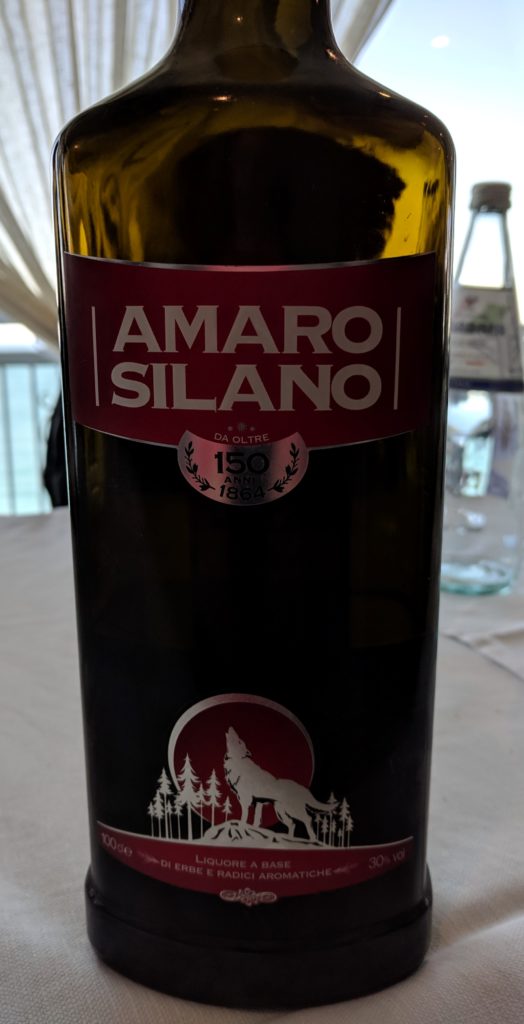
I went for a long walk after lunch. That, coupled with not having eaten the last two bites of my fish, made me feel virtuous and ready for the official welcome dinner at Al Fondaco. It is a rustic restaurant but one of the most perfectly maintained facilities I’ve seen in Italy. The same attention to detail was lavished on the food which was beyond compare…and all of it local. But if Thursday was a day of stupidly “massive eating,” I have no words to describe this meal.
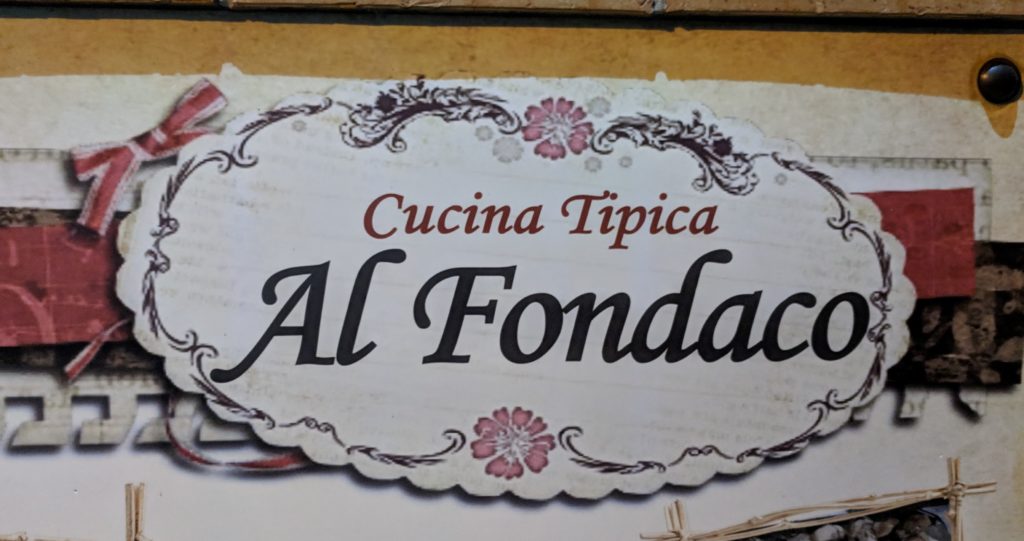
We toasted with an Italian sparkling wine then each of us got a plate of cured meats, cheeses and pickled eggplant, all made in house, accompanied by an onion jam and fruit conserve. Jugs of local red wine were put out and then the tables were littered with antipasti; so many that I can’t remember them all. They included stuffed eggplant, stuffed zucchini, suppli, savory fried dough, meatballs with large amounts of pecorino cheese in them, stuffed tomatoes, braised individual artichoke leaves with a meat topping and cheese gratin, meat croquettes and pork saltimbocca to, quite literally, name just a few. There was still silverware left on the table so we knew more was coming.
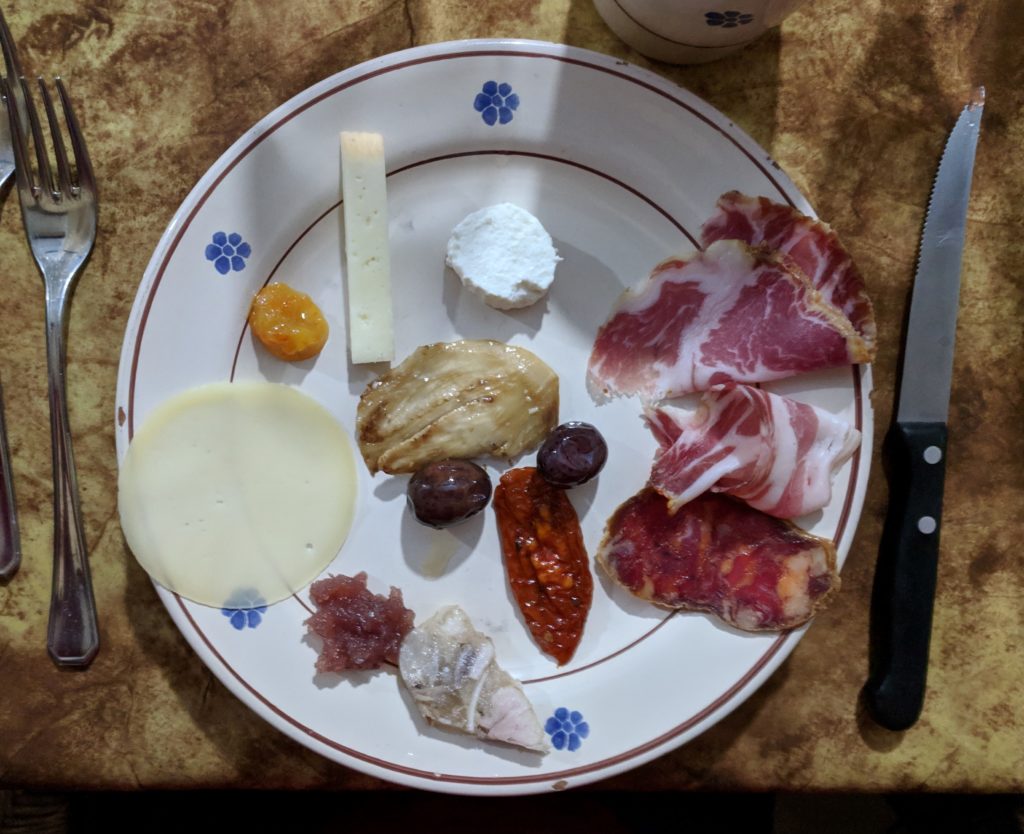
Two pasta courses followed. One that I would call strozzapreti but that’s not the Calabrese name, served in a veal ragu. The other was zucchini and pecorino ravioli in a light tomato sauce. Next came porchetta with a salad to lighten things up! Dessert consisted of a fresh cheese with a sweet syrup, tiramisu, sliced fresh fruit, walnuts, local mandarin oranges and, interestingly enough, lupini. I’ve only ever had lupini served as an antipasto or as part of a casual lunch. These were not as salty as I am accustomed to and went quite well with the remainder of the dessert course. We ended with limoncello, Amaro del Capo and espresso.
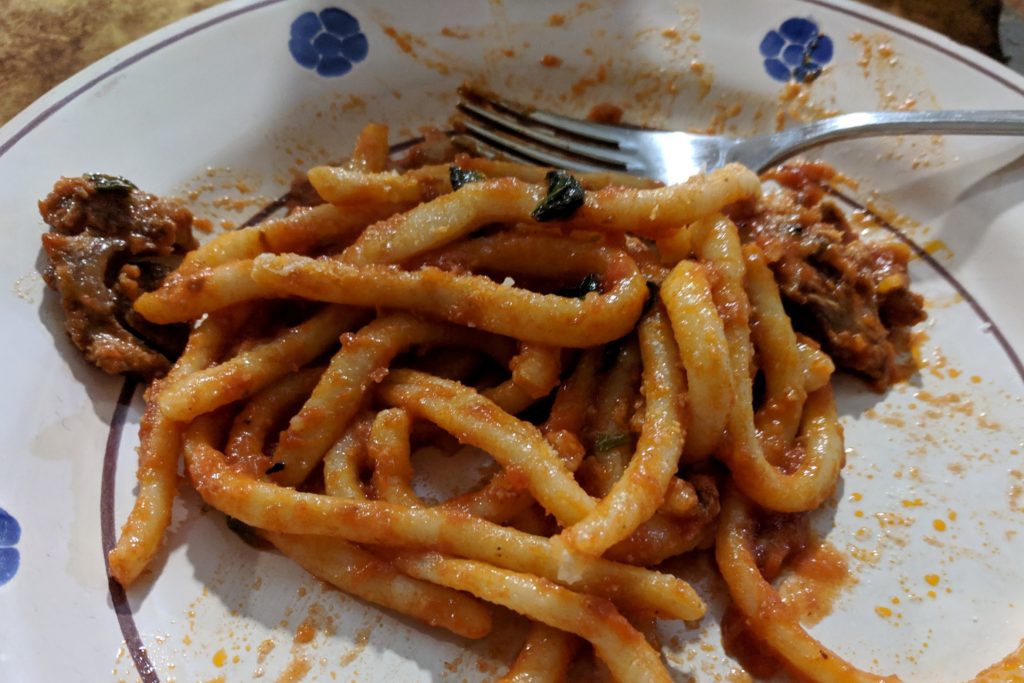
We were all subdued on the drive back to the hotel. Nearly comatose is probably a better description. Luckily, I continued to take my Pepcid after Chef Juan’s injunction a few nights earlier.
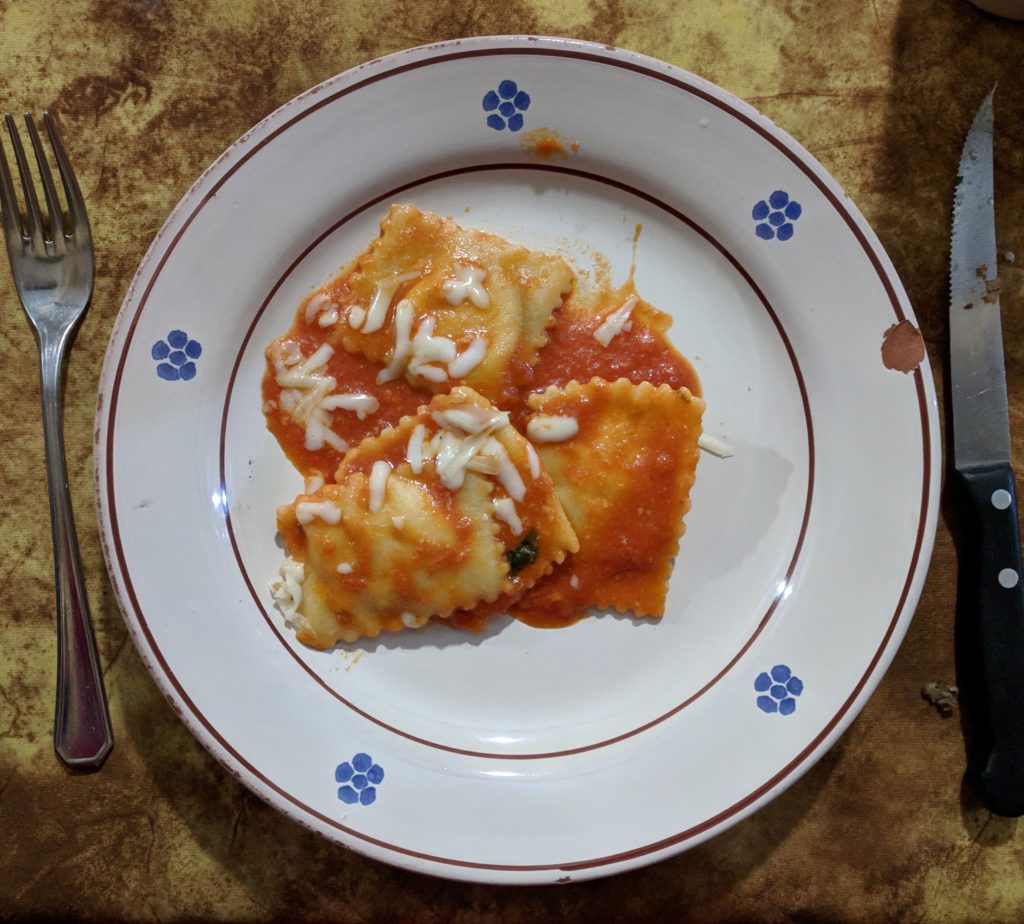
I wish I could say that I would be able to forego food for a few days but I know that won’t be possible. We report to the kitchen at 9:00 on Sunday in chef’s attire.
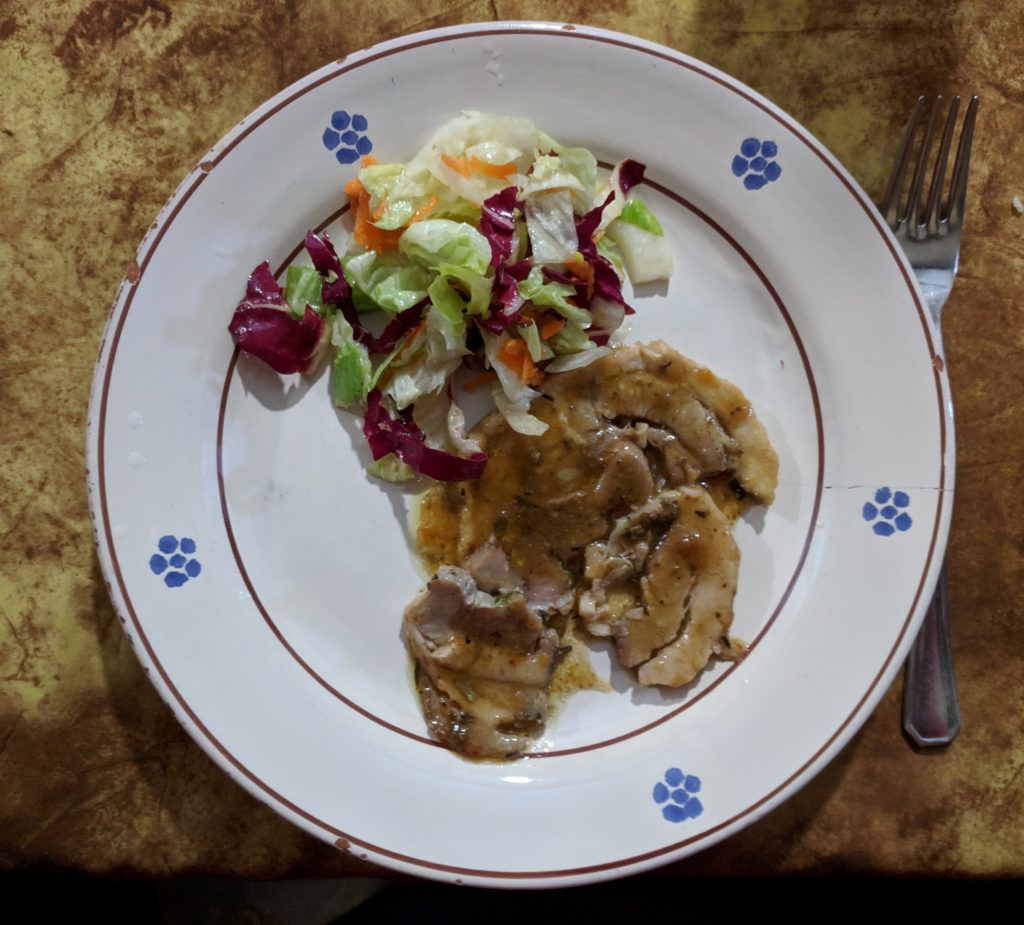
And so it begins…

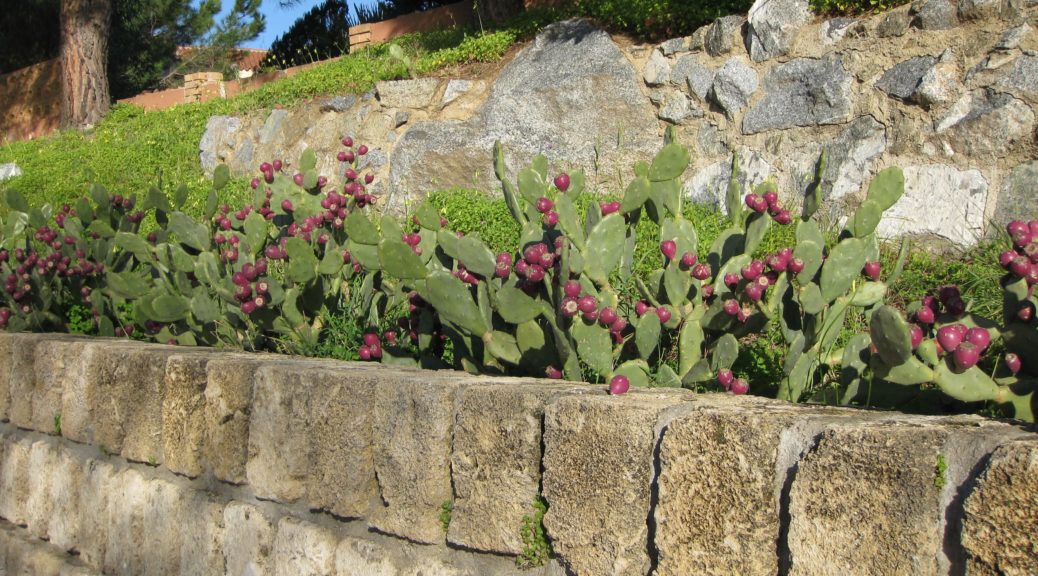
Gary – Julie and I feel so bad that we did not get to wish you bon voyage, or however you say it in Italian, before you left. We are so consumed with our own health and holiday and family issues. Julie’s sister and brother-in-law were here for over two weeks, and although they are a help, it can be very difficult at times. Please know that we love you, and we are so excited by this experience you are having. Reading your blog just now was enormously entertaining, and I thank you so much for keeping us included. I don’t know how you find the time to write when you are obviously so busy going to school… and eating!! We send you our highest hopes that this will be everything you hoped for and more. Gay and Julie
Hope you got our comment. Gay
Hi Gay and Julie,
It was wonderful to see you over the holidays! I am looking forward to seeing you both on my return in April. Although today was the first full day of the course, I joined the prior group for a bit and chatted with all the participants. I feel confident that my excellent experiences so far will continue throughout the three months. I’m already getting excited about how to put my new knowledge and skills to work upon my return.
Love the way you write your stories/experiences! I feel like I’m there with you. I even feel full thinking about all that wonderful food!! Go happy you are enjoying it all and experiencing some new creations as well. Can’t wait to taste some of your new creations! All the best!
Thanks, John! It’s really a bit of a dream to get up and just be in the kitchen.
Gary! This is all amazing! Rick and I are fasting today…to get back to a healthier pattern after the holidays…so you can imagine how I wonder that you consume so much! Incredible experience! Enjoy! See you in April!
I’m not sure myself how I consume so much but it really is necessary to taste everything to understand the flavors. It’s my sacrifice!
Great writing Gary. Karen and I have gained five pounds just reading your posts. Keep it up.
Sandy and Karen
If you gain another five you’ll be keeping up with me. It’s a good thing that chef’s pants have elastic waistbands.
mangia Gary mangia !!! This would be the typical Italian sentence said by a typical Italian grandmother , especially in the south where you are now . Well , now here you are and this is one thing you have to do “ mangiare “ . 😉
Massi: Io mangio… e mangio… e mangio…
Hi Gary, It sounds as though this class will be everything you hoped for! I am also thinking that I could recruit most graduates to my Betty Watchers (Betty Ford / Weight Watchers combination) clinic as they will be in need of treatment if this level of consumption continues! Let’s catch up via Skype soon. Rich
Gary
Thanks so much for the great descriptions and the blog . This sounds so amazing and filling!!! Cant wait to read the next post!
Mary Jo
Wow! That’s a lot of eating.
Uncle Bob has set up bookmarks so we can go directly to your blog, maps, the Culinary Institute, etc. It’s fun to be able to reference your narration with actual places we can view.
Looking forward to your next blog.
zia Ida
That sounds like a fun way to keep up with everything.
Hello Gary – Lyn and I are in our Airstream in the Arizona desert. We are worlds away from deconstructed cannoli and pig trotters. But through your words and images we can almost conjure up the tastes and experiences you describe so vividly. You are ELizabeth David, only better.
Thank-you for the compliment! I’m really enjoying writing the blog. It helps to solidify some of the experiences. I’m so glad you’re enjoying it!
Gary, I literally can’t stop laughing over this post and the amount of food prepared, served, and eaten! My stomach is hurting but probably not as much as yours! What a wonderful adventure and thank you for sharing. I am reminded of John Pinette in the Italian restaurant video, where they are chasing him with cannolis! It seems the excess in food is only matched by the excess in bureaucracy as noted in your next post. Susan
I think excess is the operative word, though mostly it’s applied to hospitality. It’s really wonderful being in Calabria. People are really warm and open.